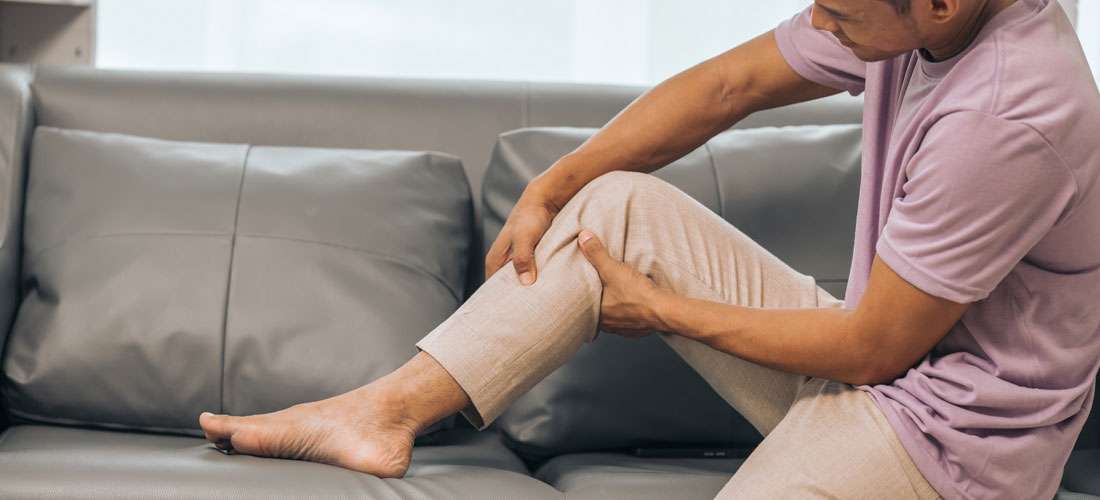Peripheral Arterial Disease (PAD)
Peripheral Artery Disease (PAD) is a chronic circulatory condition caused by the buildup of plaque—composed of fats, cholesterol, and other substances—within the arteries that supply blood to the limbs. This narrowing of the arteries, known as atherosclerosis, restricts oxygenated blood flow to the muscles and tissues, most commonly in the legs and feet.
Over time, plaque can rupture and trigger the formation of blood clots, further narrowing or fully blocking the vessel. When blood cannot adequately reach the extremities, it can result in tissue damage, ulcers, non-healing wounds, or in advanced cases, gangrene.
PAD often progresses gradually and may remain undetected until blood flow is significantly reduced. While it is a long-term condition, appropriate medical treatment and lifestyle changes can prevent complications and improve functional mobility.
PAD affects millions of people, but many remain undiagnosed or untreated.
Common symptoms of PAD
Leg pain or cramping while walking (claudication)
Numbness, tingling, or coldness in the legs or feet
Non-healing wounds on the toes, feet, or legs
Shiny skin or loss of hair on the legs
Weak pulses in the feet
Causes
The primary cause of PAD is atherosclerosis—plaque buildup in the peripheral arteries. This is similar to coronary artery disease but occurs in the arteries of the limbs. Over time, atherosclerosis reduces the diameter of the arteries and impairs blood flow.
Less common causes of PAD include:
- Vasculitis or inflammation of the blood vessels
- Trauma to the limbs
- Anatomical changes in the muscles or ligaments
- Radiation-induced vascular injury
Risk factors
- Tobacco use (most significant modifiable risk)
- Diabetes
- Age over 50
- High blood pressure (hypertension)
- High cholesterol (hyperlipidemia)
- Abdominal obesity
- Chronic kidney disease
- Family or personal history of cardiovascular disease
PAD shares risk factors with coronary artery disease. Patients with one condition are at increased risk for the other, as well as for stroke and heart attack.
Stages
PAD severity is classified using clinical staging systems such as Fontaine or Rutherford. The Fontaine classification is commonly used:
- Stage I: Asymptomatic
- Stage IIa: Mild claudication
- Stage IIb: Moderate to severe claudication
- Stage III: Ischemic rest pain
- Stage IV: Ulceration or gangrene
Diagnosis
Diagnosis involves a combination of clinical assessment and vascular imaging:
- Ankle-Brachial Index (ABI): Compares blood pressure in the ankle and arm to detect reduced blood flow.
- Doppler Ultrasound: Non-invasive imaging to visualize blood flow and locate arterial narrowing or blockages.
- Pulse Volume Recording (PVR): Measures blood volume changes in the limb with each heartbeat.
- CT Angiography or MR Angiography: Cross-sectional imaging with contrast to map arterial anatomy.
- Invasive Angiography: Used when intervention is being planned; contrast dye is injected into arteries to visualize blockages in real-time.
- Blood tests are also performed to evaluate for diabetes, dyslipidemia, and other underlying risk factors.
Why treat PAD early?
Prevents progression to critical limb ischemia
Reduces risk of amputation
Improves walking distance and quality of life
Helps wounds and ulcers heal faster
Reduces risk of heart attack or stroke (PAD is linked to cardiovascular disease)
How PAD treatment works at RIVEA
We use advanced, image-guided techniques to reopen narrowed arteries and restore proper blood flow. Depending on your condition, the treatment may include:
Treatment depends on the severity of the condition and the patient's overall health. The goal is to restore adequate blood flow, relieve symptoms, and prevent limb loss.
Lifestyle and Medical Management
- Stopping smoking
- Supervised exercise programs
- Cholesterol-lowering agents (statins)
- Blood pressure and blood sugar control
- Antiplatelet therapy (aspirin or clopidogrel)
Minimally Invasive Endovascular Treatments
We use advanced, image-guided techniques to reopen narrowed arteries and restore proper blood flow. These are typically performed under local anesthesia with minimal recovery time. Depending on your condition, the treatment may include:
These procedures are done through a small puncture. No open surgery or stitches are required.
Surgical Interventions
In certain cases, surgical bypass may be required. A graft (synthetic or vein) is used to route blood around the blocked artery. This is reserved for patients who are not suitable for endovascular options or have extensive blockages.
Why choose RIVEA for PAD treatment?
At RIVEA Vascular Institute, patients receive advanced PAD care delivered by a team led by Stanford-trained and American-Board certified vascular and endovascular specialist, Dr. Karthik Mikkineni. The facility is equipped with:
- A Hybrid Operating Room that combines surgical and advanced imaging capabilities
- Non-surgical and minimally invasive techniques that reduce hospital stays, lower complication rates, and accelerate recovery
- Precision imaging for accurate diagnosis and targeted treatment
- Customized treatment plans based on disease severity, patient lifestyle, and limb preservation goals
- Integrated limb salvage protocols for high-risk or diabetic patients
RIVEA’s commitment to evidence-based care, rapid intervention, and long-term follow-up ensures optimal outcomes for patients with PAD.
RIVEA offers:
Vascular experts trained in complex limb-saving procedures
Advanced diagnostics and imaging tools
Personalized care plans tailored to your lifestyle and health goals
Minimally invasive techniques with quicker recovery and fewer risks
FAQs
What causes PAD?
PAD is usually caused by atherosclerosis—a buildup of fatty deposits (plaque) in the arteries that restricts blood flow to the limbs.
What are the risk factors for PAD?
Common risk factors include:
- Diabetes
- Smoking
- High blood pressure
- High cholesterol
- Age over 50
- Family history of cardiovascular disease
How is PAD diagnosed?
Tests include:
- Physical exam and pulse check
- Ankle-Brachial Index (ABI)
- Doppler ultrasound or CT angiography
Is PAD reversible?
While the damage may not be fully reversible, early intervention can greatly improve symptoms and stop progression.
What happens if PAD is left untreated?
PAD can lead to critical limb ischemia, non-healing wounds, infections, and in severe cases, amputation. It also increases your risk of heart attack and stroke.
Are PAD treatments painful?
No. Minimally invasive procedures are done with local anesthesia and mild sedation. Most patients go home the same day.
Can PAD come back after treatment?
Yes, especially if risk factors like smoking or diabetes aren't controlled. Ongoing care and lifestyle changes are key to long-term results.
How long is recovery after angioplasty or stenting?
You can typically start walking within 8–10 hours after the procedure. Minimal discomfort and no major impact on daily activities.
What’s the best treatment for PAD?
Balloon angioplasty with stenting is considered the most advanced and least invasive option for suitable patients.
Are there any side effects from PAD treatment?
No major side effects. Minor pain or bruising at the puncture site may occur initially, but most people resume normal activities quickly.
Click here to learn more about:
Vascular & Endovascular Surgery
For any inquiries, post your query here:
Ask Rivea
Contact us today to explore your options.
Call Now
Our Team
-

Dr. Karthik Mikkineni
MD, FACS, FSVS, RPVI
Dr. Karthik Mikkineni is an internationally recognized vascular and endovascular surgeon, known for his pioneering work in complex aortic interventions, limb salvage, and carotid disease management.
View Profile Book an Appointment




